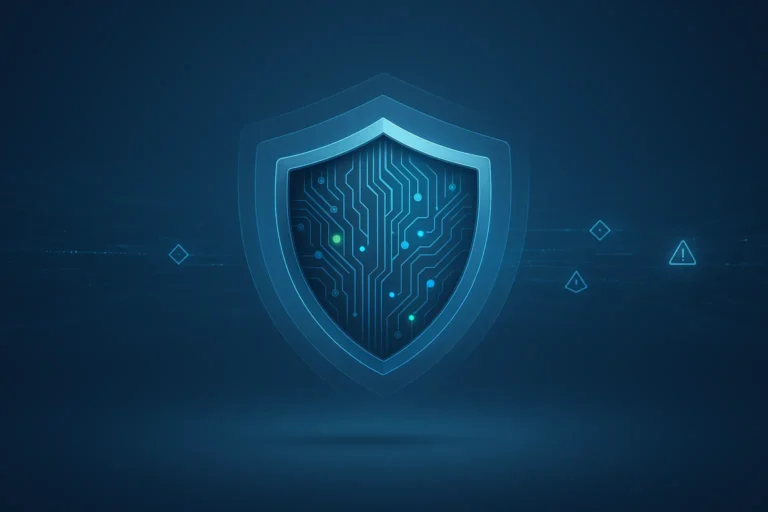Cybersecurity compliance has evolved beyond checkbox exercises to become an essential defense strategy against emerging threats, as confirmed by experts in the field. Threat intelligence provides organizations with actionable insights that strengthen security posture while simultaneously satisfying regulatory requirements across healthcare, IoT, and other vulnerable sectors. By implementing AI-driven monitoring systems and risk-based approaches, companies can transform static compliance procedures into dynamic protection mechanisms that deliver competitive advantages and cost savings.
- Customized Threat Monitoring Creates Competitive Advantage
- Threat Feeds Link Compliance to Meaningful Defense
- Evidence-Based Actions Lower Cybersecurity Insurance Premiums
- IoT Vulnerability Detection Prevents Regulatory Fines
- Real-World Threat Response Accelerates Gap Closure
- POS Malware Insights Test Beyond Audit Requirements
- Early Phishing Detection Shifts Security Mindset
- Live Threat Data Builds Risk-Based Audit Trail
- Risk Scoring Enables Proactive Compliance Risk Management
- Proactively Monitor Healthcare Risks with Threat Intel
- Real-Time Intelligence Strengthens HIPAA Security Compliance
- Focus on Active Threats Reduces Compliance Noise
- AI-Driven Pipeline Transforms Static Compliance Processes
- Threat-Led Loop Maps Intel to Control Updates
Customized Threat Monitoring Creates Competitive Advantage
I’ve seen how threat intelligence transforms compliance from reactive checkbox-ticking to proactive defense.
We had a financial services client who was struggling with PCI DSS compliance audits. Instead of just meeting the basic requirements, we implemented threat intelligence feeds that monitored for credit card data being sold on dark web marketplaces. Within two months, we detected their data wasn’t compromised, but three of their vendors were actively being targeted by the same threat actors.
The real game-changer was when threat intelligence showed us that 95% of successful attacks in their industry started with spear-phishing emails containing specific industry terminology. We used this intel to customize their employee training beyond generic awareness — focusing on the exact phrases and sender patterns targeting financial firms. Their next compliance audit went from “meets requirements” to “exemplary security posture.”
The biggest benefit I’ve observed is that threat intelligence turns compliance from a cost center into a competitive advantage. Instead of scrambling to meet regulatory minimums, businesses can demonstrate to auditors and clients that they’re anticipating and preventing the specific threats facing their industry.

Threat Feeds Link Compliance to Meaningful Defense
Threat intelligence can be especially powerful when integrated into compliance-driven processes. For example, on one recent project, we tied external threat feeds into our vulnerability management workflow itself. Instead of relying only on quarterly scans, we applied patches according to whether flaws were being actively targeted in the wild. This methodology allowed us not just to tick the PCI-DSS or HIPAA boxes, but to orient all our compliance efforts around risks. That practical link between intelligence and action made our reporting more meaningful, since we could demonstrate that remediation was driven by active threats rather than theoretical ones.
The biggest benefit I have seen is efficiency. Too frequently, compliance feels like a paper exercise, but with threat intelligence you can shift the focus to meaningful defense. For instance, mapping known phishing campaigns or ransomware variations against specific controls allows an organization to verify that their email filtering, backups, and incident response plans are in fact properly synchronized with current threats. This is what clients like — it gives them that comfort level that compliance is not just a tick in the audit book; it’s actual armor. In my view, the organizations that weave threat intelligence into their compliance posture not only pass audits with fewer issues but also strengthen their day-to-day resilience.

Evidence-Based Actions Lower Cybersecurity Insurance Premiums
One instance that stands out is when we leveraged threat intelligence to address gaps in a client’s cybersecurity insurance requirements. They were a mid-sized law firm, and while their internal IT team had solid fundamentals, they weren’t actively monitoring threat feeds. We started pulling intelligence from multiple sources — CISA alerts, vendor-specific threat reports, and dark web monitoring — and quickly identified that their remote desktop protocol (RDP) configuration was being scanned regularly by known botnets. The client had no idea they were being targeted so directly.
With that intel, we tightened firewall rules, added geo-blocking, and moved them to a more secure remote access platform. The real benefit wasn’t just improved security — it provided the client with the documentation they needed to meet stricter insurance criteria and lower their premiums. Using real threat data helped us shift from “checking boxes” to taking proactive, evidence-based actions that made both the client and their insurer more confident in their risk posture.

IoT Vulnerability Detection Prevents Regulatory Fines
I’ve seen how threat intelligence transforms compliance from reactive checkbox-ticking to proactive risk management.
Last year, we integrated threat intelligence feeds specifically targeting IoT vulnerabilities for a manufacturing client who was struggling with regulatory compliance audits. The intelligence identified a zero-day exploit targeting their connected factory equipment three weeks before it went public. We patched their entire IoT infrastructure and documented the proactive response, which turned their next compliance audit from a nightmare into a showcase of their security posture.
The compliance benefits were immediate and measurable. Their audit findings dropped from 47 critical items to just 3 minor recommendations, saving them roughly $180,000 in potential fines and remediation costs. More importantly, they could demonstrate to regulators that they had predictive threat awareness, not just reactive incident response.
What I tell clients is that threat intelligence doesn’t just help you avoid attacks — it creates a paper trail that compliance officers love to see. When you can show auditors that you’re actively hunting threats before they become incidents, you’re speaking their language.

Real-World Threat Response Accelerates Gap Closure
One of our clients recently faced a serious risk. Attackers were actively exploiting a VPN tool they used, targeting exposed admin panels with default credentials. Our threat intelligence feeds picked this up, and we quickly correlated it with their environment, confirming they were exposed.
We worked with their team to patch the VPN, enforce MFA, and remove excess entitlements. Every step was logged in their compliance dashboard and mapped to PCI DSS and ISO 27001.
The outcome was simple but powerful: they closed the gap in hours instead of weeks and strengthened their compliance posture with proof tied to real-world threats.

POS Malware Insights Test Beyond Audit Requirements
Threat intel flagged a rise in customized POS malware being traded on underground forums in our region. Using this intelligence, we mapped the risk directly to PCI DSS Requirement 11 (testing systems) and simulated the malware behavior during red team exercises. This ensured the client’s defenses and monitoring controls were not only compliant but tested against real-world attacks. The benefit? They closed detection gaps auditors typically don’t check, while also proving proactive compliance to acquiring banks.
When we integrated threat intelligence into our PCI DSS testing, one of the biggest benefits was being able to detect attack patterns much earlier, rather than waiting for them to show up in logs after the fact. It also made our compliance audits smoother, because we could demonstrate to auditors that our testing was mapped to real-world threats, not just theoretical scenarios. Most importantly, it gave the executive team confidence that PCI DSS wasn’t just a checkbox exercise, but a living defense aligned to the threats we were actually facing.

Early Phishing Detection Shifts Security Mindset
A few years ago, I worked with a law firm that handled sensitive client data but had minimal cybersecurity controls in place beyond the basics. We started using a threat intelligence platform to monitor indicators of compromise (IOCs) and known phishing campaigns targeting the legal industry. Within the first month, we detected a spoofed domain mimicking the firm’s website being used to send phishing emails. Because we were plugged into that intel feed, we were able to act quickly — report the domain, alert clients, and tighten our SPF/DKIM/DMARC records.
The benefit wasn’t just in catching that one issue — it shifted the firm’s whole mindset around compliance. Instead of treating security as a checkbox exercise, they saw how proactive monitoring added real value. Their board took it seriously, and it made our regular audits far smoother. Threat intelligence turned security from a vague risk into something tangible and actionable, and that buy-in made all the difference.

Live Threat Data Builds Risk-Based Audit Trail
For example, we added threat intelligence feeds to our program for managing vulnerabilities. We didn’t treat compliance scans like static checklists. Instead, we linked live threat data to the controls we were already required to keep up with, like patch timelines and access controls.
This changed our approach to compliance from reactive to proactive. For example, when intelligence told us that a zero-day was being actively exploited, we put patching at the top of our list and wrote down what we did as part of our audit trail. That not only kept us in line with what the rules said, but it also showed auditors that our program was based on risk, not just checking boxes.
There have been two benefits: fewer audit findings and a stronger security culture where following the rules is directly linked to real-world threats.

Risk Scoring Enables Proactive Compliance Risk Management
As cybercriminals continue evolving their tactics and techniques to target defenses, it can be challenging for organizations to keep up without information on defenses.
Threat intelligence offers the needed insights about threat actors, enabling defenders to proactively tune their defenses according to the latest tactics, methods, techniques, and procedures deployed by cybercriminals.
For example, our platform offers threat intelligence from multiple sources and industry-trusted frameworks (MITRE and D3FEND). It assigns a risk score to systems based on a detailed scan against the latest multi-sourced threat intelligence. The risk score enables teams to promptly take action to address security and compliance risks before they turn into a severe security threat.
Here are the benefits of threat intelligence:
1. Offers a detailed context of risks/threats
2. Enables teams to:
precisely detect and respond to threats
proactively address security and compliance risks
identify assets at risk
prioritize risks to treat with added context on them
save time on investigating risks and threats
predict threats
3. Helps make long-term strategic business decisions
4. It can help organizations from industries like healthcare, finance, manufacturing, and the banking sector to monitor, detect, prevent/respond to threats, and secure their sensitive data
5. It helps enhance security posture by providing the much-needed information to update security measures, controls, policies, etc.

Proactively Monitor Healthcare Risks with Threat Intel
One way we’ve used threat intelligence is by integrating it directly into our monitoring and compliance systems. Instead of waiting for issues to surface, we actively track emerging risks and vulnerabilities that are specific to healthcare and SaaS platforms. That means we can adapt policies, patch systems, and update training before those threats become real problems.
The biggest benefit has been moving from a reactive stance to a proactive one. By folding threat intelligence into our compliance posture, audits and security reviews are smoother, and we can demonstrate not only that we meet requirements, but that we’re consistently improving. It also builds confidence for our users. They know we’re not just checking boxes, but actively protecting their data in a changing threat landscape.
For me, the real win is that it makes security part of the culture, not just a technical process. Everyone on the team becomes more aware and engaged, which is ultimately the strongest defense we have.

Real-Time Intelligence Strengthens HIPAA Security Compliance
In the fast-paced healthcare industry, staying ahead of cyber threats is not just a matter of protecting data, it’s about ensuring compliance with regulations like HIPAA. A few years ago, I faced a pivotal challenge: our team needed to enhance our cybersecurity compliance while managing an increasingly complex threat landscape. The solution came from integrating threat intelligence into our security operations.
We started by incorporating real-time threat feeds into our Security Information and Event Management (SIEM) system. This allowed us to detect vulnerabilities before they could be exploited, especially in widely used applications that stored sensitive patient data. For instance, when a new zero-day vulnerability in a popular patient management system was identified, we were able to patch it quickly and prevent any potential breach. This proactive approach not only reduced the risk of an attack but also kept us in line with HIPAA’s security standards.
One of the biggest benefits was improving our incident response. During a simulated phishing attack, threat intelligence provided context about the attack’s tactics, techniques, and procedures (TTPs). This insight allowed us to contain the incident more swiftly and accurately, ensuring compliance with HIPAA’s breach notification timelines.
We also leveraged threat intelligence to automate continuous monitoring of our systems, generating real-time alerts about suspicious activity. This kept us vigilant, reduced manual effort, and ensured we met the constant auditing requirements of healthcare regulations.
By using threat intelligence, we didn’t just protect data; we built a robust cybersecurity compliance posture that kept us ahead of the curve, saved time, and reduced risk. It was a game-changer for both our security and regulatory alignment.

Focus on Active Threats Reduces Compliance Noise
When we tightened our compliance posture, threat intelligence was the piece that turned theory into something practical. Instead of just checking boxes for a framework, we pulled in live intelligence feeds to see which vulnerabilities were actually being exploited in the wild. That shifted our patching priorities because this time, we didn’t waste time on low-risk items while leaving the door open on something attackers were actively scanning for.
The benefit was twofold: audits went smoother because we could show a clear, risk-based rationale for our decisions, and the team had more confidence that we weren’t just compliant on paper but resilient in practice. It also cut down on alert fatigue because when you focus on what really matters, the noise drops and the signal gets stronger.

AI-Driven Pipeline Transforms Static Compliance Processes
Integrating threat intelligence into our compliance efforts has been a game-changer. Rather than treating compliance as a static checklist, we use intelligence feeds to anticipate risks that regulators are increasingly concerned about, such as data exfiltration attempts or supply chain vulnerabilities.
For example, we built an AI-driven pipeline that ingests threat intel from multiple sources, correlates it with our own network activity, and then highlights patterns that could map to compliance gaps.
In one case, this helped us detect enormous access attempts against third-party integrations. It helped us in two ways; we were able to mitigate the risk early, but we also used the incident to update our access-control policies in line with ISO and GDPR requirements.
The real benefit I’ve seen is that compliance stops being a box-ticking exercise and starts becoming part of day-to-day defense. Instead of reacting only when an auditor points out a gap, we can show that our controls adapt as new threats emerge. That shift not only makes audits smoother but also builds confidence with regulators and, more importantly, with customers who trust us to safeguard their data.

Threat-Led Loop Maps Intel to Control Updates
We run a threat-led compliance loop. Our Threat Intelligence (TI) stack (API abuse intel, credential-stuffing lists, OTP-bypass kits) feeds a risk board that maps to SOC 2 / ISO 27001 controls. When TI detected an increase in residential proxy login attacks, we implemented velocity rules, ASN reputation checks, and WebAuthn step-up for high-risk sessions. We wrote the change as a control update in Jira, linked evidence (configs, SIEM detections), and referenced the TI ticket so auditors can trace threat – control – proof.
Benefits: credential-stuffing success rate down 74%, false-positive logins down 29%, and a faster SOC 2 Type II review because evidence was pre-tagged to controls.
My filter: if TI doesn’t move F1 of our detections, Mean Time To Respond (MTTR), or an audit test, it’s trivia. When it does, it becomes policy.




